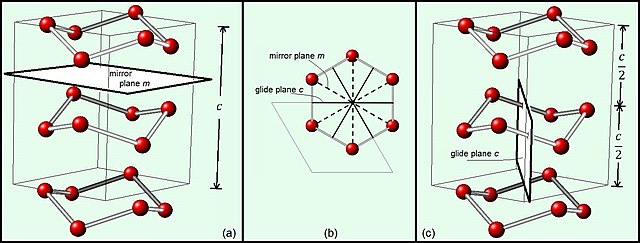In mathematics, physics and chemistry, a space group is the symmetry group of a repeating pattern in space, usually in three dimensions. The elements of a space group are the rigid transformations of the pattern that leave it unchanged. In three dimensions, space groups are classified into 219 distinct types, or 230 types if chiral copies are considered distinct. Space groups are discrete cocompact groups of isometries of an oriented Euclidean space in any number of dimensions. In dimensions other than 3, they are sometimes called Bieberbach groups.
The space group of hexagonal H2O ice is P63/mmc. The first m indicates the mirror plane perpendicular to the c-axis (a), the second m indicates the mirror planes parallel to the c-axis (b), and the c indicates the glide planes (b) and (c). The black boxes outline the unit cell.
In mathematics, a symmetry operation is a geometric transformation of an object that leaves the object looking the same after it has been carried out. For example, a 1⁄3 turn rotation of a regular triangle about its center, a reflection of a square across its diagonal, a translation of the Euclidean plane, or a point reflection of a sphere through its center are all symmetry operations. Each symmetry operation is performed with respect to some symmetry element. Symmetry operations can be classified either as point symmetry operations or as travel symmetry operations.
Reflection operation
Inversion operation is shown here with a sulfur hexafluoride molecule. All of the fluorine atoms change their position to opposite side with respect to the sulfur center



